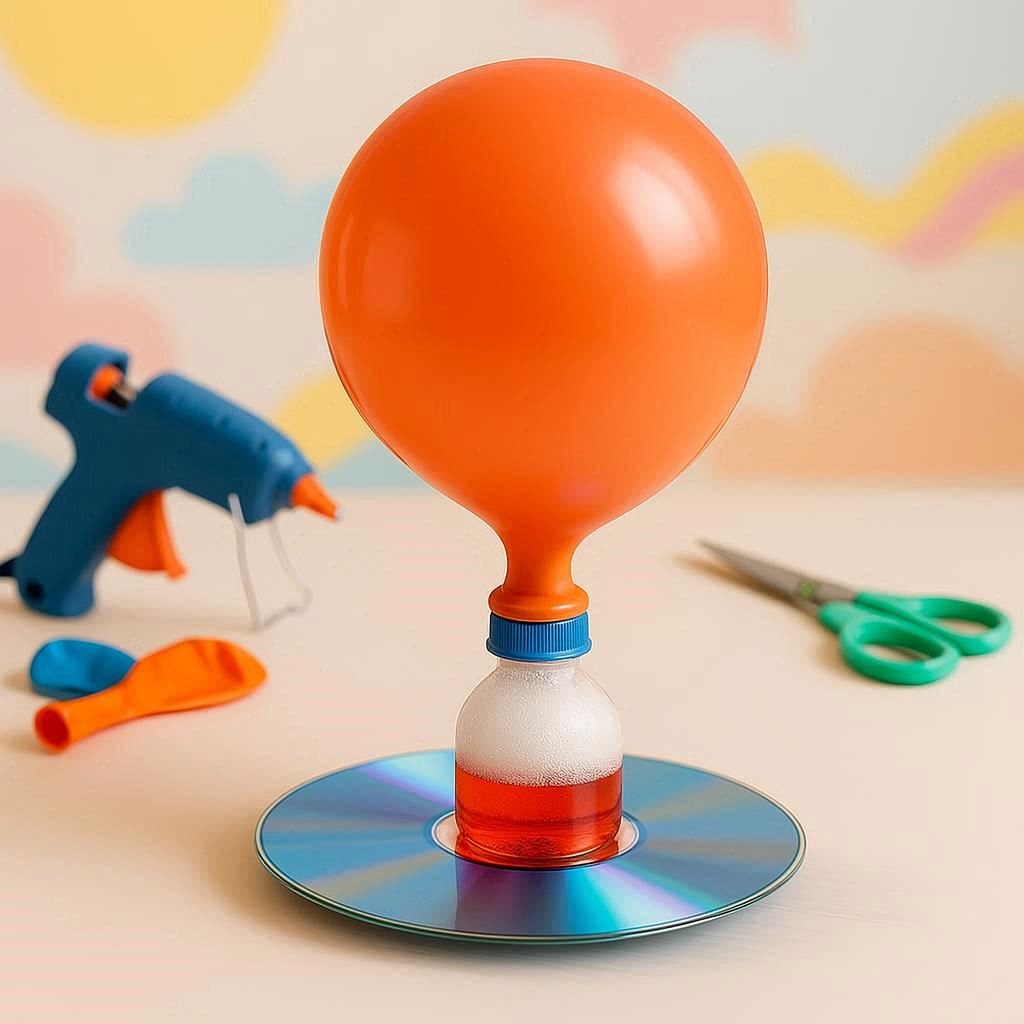A Journey into Frictionless Motion
champions of STEM education, physics enthusiasts, and anyone fascinated by the wonders of motion, gather around! Today, we’re diving into a unique and captivating project that makes the impossible possible: the Balloon Hovercraft. This ingenious invention explores the concept of frictionless motion, offering a hands-on experience with the principles of physics. Whether you’re a student, a teacher, or simply a curious mind, this project promises to amaze and educate.
What is a Balloon Hovercraft?
Imagine a small, lightweight platform that floats effortlessly on a cushion of air, propelled forward by the gentle pressure of inflated balloons. The Balloon Hovercraft is an innovative device that demonstrates the principles of fluid dynamics, buoyancy, and motion. By harnessing the power of air pressure and the concept of reduced friction, this simple yet elegant invention can glide smoothly across a flat surface, leaving onlookers in awe.
How Does a Balloon Hovercraft Work?
At the heart of the Balloon Hovercraft lies the principle of air pressure. When balloons are inflated, the air molecules inside exert pressure against the inner walls of the balloon. This pressure is what creates the force needed to propel the hovercraft forward. By designing a platform that allows this air pressure to be harnessed effectively, the Balloon Hovercraft achieves a state of near-frictionless motion.
The Hovercraft’s functionality can be broken down into three key components:
- The Platform: This is the base of the hovercraft, typically made from lightweight materials such as cardboard, foam, or plastic. The platform supports the balloons and provides a surface for the hovercraft to move on.
- The Balloons: These are the powerhouses of the hovercraft. As the balloons deflate, they push air out, creating a pressure differential that generates thrust. The shape and size of the balloons can affect the performance of the hovercraft.
- The Skirt: This is a flexible barrier that surrounds the edge of the platform, ensuring that the air pressure from the balloons is directed downwards, creating a cushion of air upon which the hovercraft floats.
The Science Behind Frictionless Motion
Friction, the force that opposes motion between surfaces in contact, is a fundamental concept in physics. While it’s impossible to achieve zero friction in most real-world scenarios, the Balloon Hovercraft comes remarkably close by utilizing the principle of air lubrication.
When the hovercraft is in motion, the air pressure from the balloons creates a thin layer of air between the platform and the surface it’s moving on. This layer of air acts as a lubricant, reducing the frictional forces to a minimum. As a result, the hovercraft can move with very little resistance, showcasing the concept of near-frictionless motion.
DIY Guide: Build Your Own Balloon Hovercraft
Ready to embark on this exciting project? Here’s a step-by-step guide to building your very own Balloon Hovercraft:
Materials Needed:
- Sturdy cardboard or plastic sheet (for the platform)
- Balloons (preferably large, durable ones)
- Scissors
- Glue or a hot glue gun
- Tape
- A plastic bag or flexible sheet (for the skirt)
- A straw or small tube
- Decorative items (optional)
Step 1: Design the Platform
Cut your cardboard or plastic sheet into a circular or oval shape, depending on your preference. Ensure the platform is large enough to hold the balloons but lightweight enough for smooth movement.
Step 2: Attach the Balloons
Inflate the balloons to the desired size and secure them to the underside of the platform using glue, tape, or a hot glue gun. Make sure they’re evenly spaced for maximum efficiency.
Step 3: Create the Skirt
Cut the plastic bag or flexible sheet into a strip that matches the circumference of the platform. Attach this strip around the edges of the platform using glue or tape. This skirt will direct the airflow and create the cushion of air necessary for frictionless motion.
Step 4: Add the Propulsion System
Insert the straw or small tube into the platform near the balloons. This will serve as a makeshift propulsion system, allowing you to control the direction of the hovercraft.
Step 5: Test and Refine
Place the hovercraft on a smooth surface and watch it glide effortlessly. Experiment with different balloon sizes, skirt designs, and platform materials to optimize its performance.
Applications of the Balloon Hovercraft
The Balloon Hovercraft isn’t just a fun DIY project; it has practical applications in various fields:
- Education: The Balloon Hovercraft is an excellent teaching tool for introducing students to fundamental concepts in physics, engineering, and fluid dynamics.
- Research: The principles behind the hovercraft can be scaled up for more complex research projects, such as studying air lubrication in industrial settings.
- Entertainment: Whether it’s a school science fair or a community event, the Balloon Hovercraft is sure to captivate audiences of all ages.
- Innovation: The concept of the Balloon Hovercraft challenges the boundaries of traditional transportation methods, inspiring creative solutions to real-world problems.
Exploring Variations of the Balloon Hovercraft
Once you’ve mastered the basic Balloon Hovercraft, why not take it to the next level? Here are some variations to try:
- Multiple Balloons: Experiment with different numbers and sizes of balloons to see how they affect the hovercraft’s performance.
- Adjustable Skirt: Design a skirt that can be adjusted in height or angle to optimize the air cushion.
- Remote Control: Introduce a remote-controlled system to manage the hovercraft’s movement without physical contact.
- Hybrid Designs: Combine the Balloon Hovercraft with other propulsion methods, such as small fans or motors, for enhanced functionality.
The Balloon Hovercraft is a testament to the power of creativity and the importance of hands-on learning. By experimenting with different materials and designs, you can unlock new possibilities and push the limits of what’s thought to be possible.
Troubleshooting Tips
Like any project, the Balloon Hovercraft may present some challenges. Here are some common issues and their solutions:
- Balloon Popping: Use high-quality, durable balloons to minimize the risk of popping. Ensure the balloons are securely attached to the platform.
- Loss of Air Pressure: Check for any leaks in the balloons or skirt. Regularly inflate the balloons to maintain optimal air pressure.
- Uneven Movement: Adjust the balance of the platform and ensure the skirt is evenly attached. Experiment with different materials for the platform to find the best weight-to-strength ratio.
- Lack of Propulsion: Ensure the straw or tube used for propulsion is unobstructed and properly aligned. Experiment with different angles and positions for the straw to achieve maximum effect.
Conclusion: Embrace the Future of Motion
The Balloon Hovercraft is more than just a captivating DIY project; it’s a gateway to a world of scientific discovery and innovation. By understanding and applying the principles behind this invention, we can gain valuable insights into the forces that shape our world.
Whether you’re a seasoned scientist or a curious beginner, the Balloon Hovercraft offers a unique opportunity to explore the concept of frictionless motion. With its simplicity, adaptability, and potential for creativity, this project is sure to inspire the next generation of thinkers and inventors.
So, gather your materials, inflate those balloons, and get ready to embark on a journey into the fascinating world of the Balloon Hovercraft. The future of motion is at your fingertips—explore it today!



